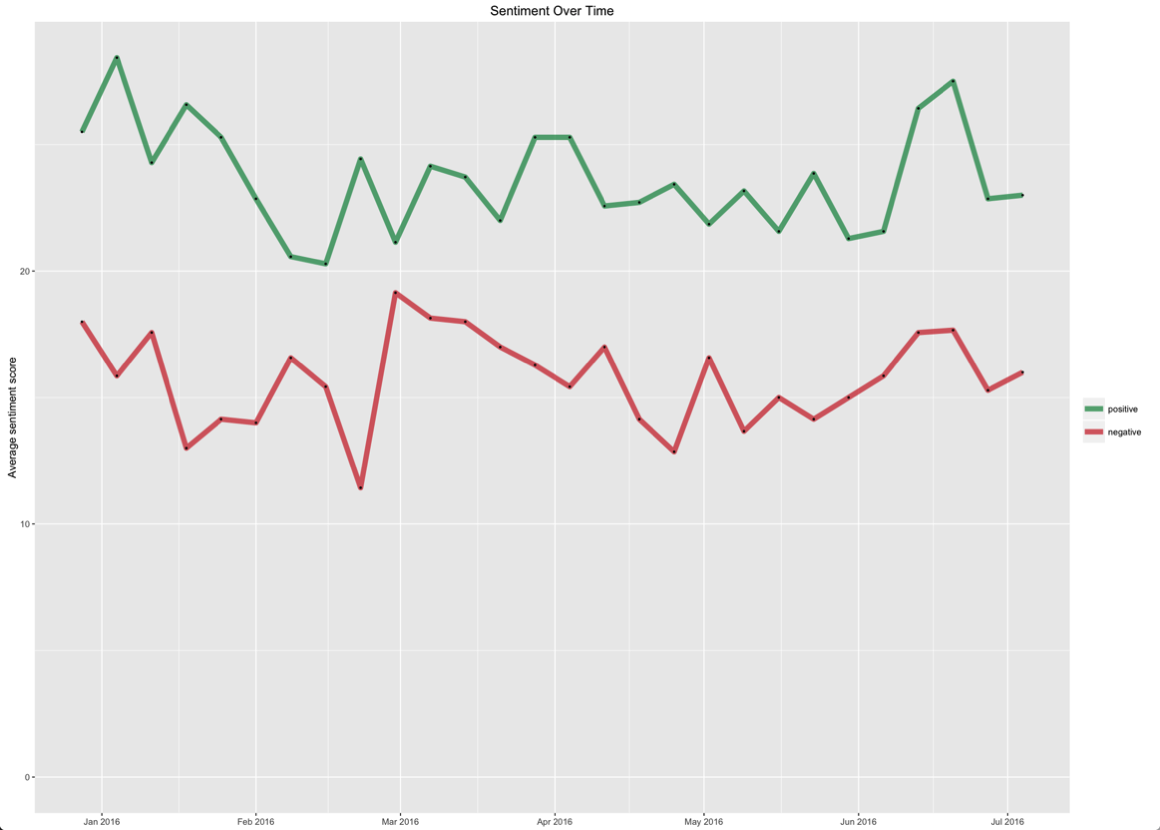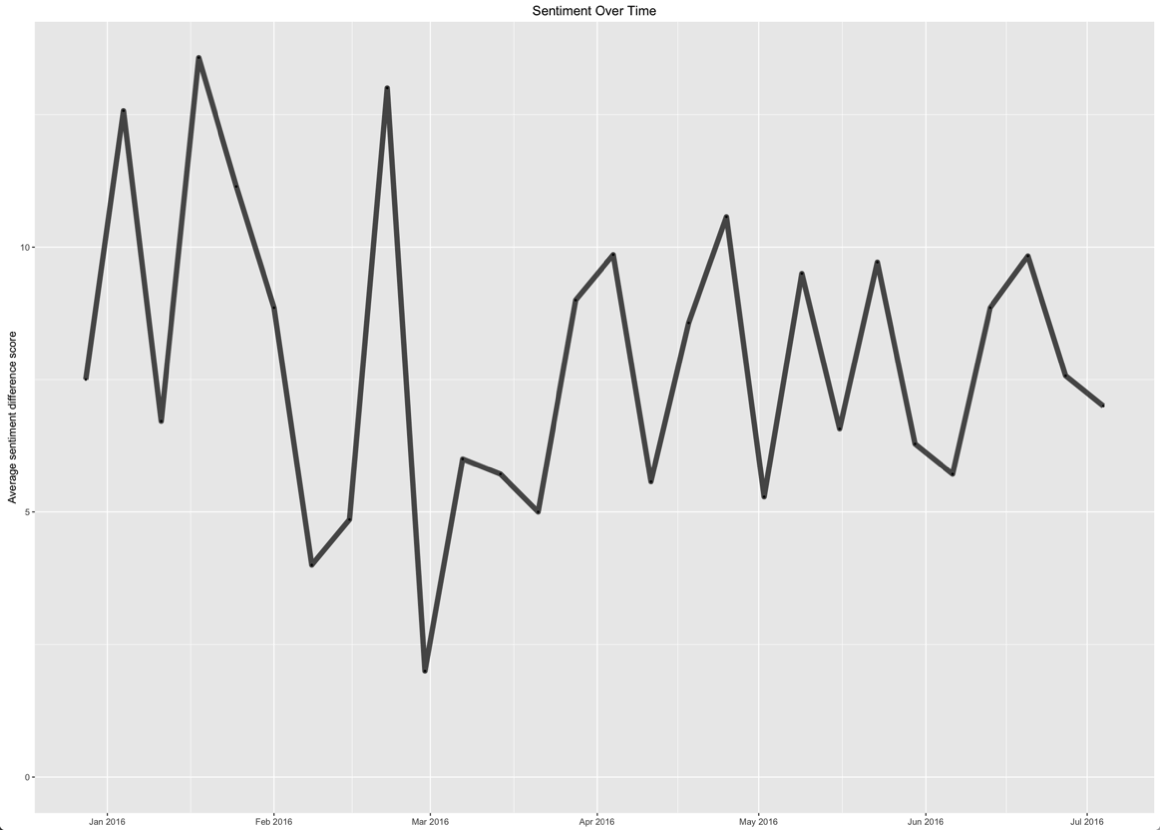R: Sentiment analysis of morning pages
A couple of months ago I came across a cool blog post by Julia Silge where she runs a sentiment analysis algorithm over her tweet stream to see how her tweet sentiment has varied over time.
I wanted to give it a try but couldn’t figure out how to get a dump of my tweets so I decided to try it out on the text from my morning pages writing which I’ve been experimenting with for a few months.
Here’s an explanation of morning pages if you haven’t come across it before:
Morning Pages are three pages of longhand, stream of consciousness writing, done first thing in the morning. There is no wrong way to do Morning Pages — they are not high art. They are not even “writing.” They are about anything and everything that crosses your mind-- and they are for your eyes only. Morning Pages provoke, clarify, comfort, cajole, prioritize and synchronize the day at hand. Do not over-think Morning Pages: just put three pages of anything on the page…and then do three more pages tomorrow.
Most of my writing is complete gibberish but I thought it’d be fun to see how my mood changes over time and see if it identifies any peaks or troughs in sentiment that I could then look into further.
I’ve got one file per day so we’ll start by building a data frame containing the text, one row per day:
library(syuzhet)
library(lubridate)
library(ggplot2)
library(scales)
library(reshape2)
library(dplyr)
root="/path/to/files"
files = list.files(root)
df = data.frame(file = files, stringsAsFactors=FALSE)
df$fullPath = paste(root, df$file, sep = "/")
df$text = sapply(df$fullPath, get_text_as_string)We end up with a data frame with 3 fields:
> names(df)
[1] "file" "fullPath" "text"Next we’ll run the sentiment analysis function - syuzhet#get_nrc_sentiment - over the data frame and get a score for each type of sentiment for each entry:
get_nrc_sentiment(df$text) %>% head()
anger anticipation disgust fear joy sadness surprise trust negative positive
1 7 14 5 7 8 6 6 12 14 27
2 11 12 2 13 9 10 4 11 22 24
3 6 12 3 8 7 7 5 13 16 21
4 5 17 4 7 10 6 7 13 16 37
5 4 13 3 7 7 9 5 14 16 25
6 7 11 5 7 8 8 6 15 16 26Now we’ll merge these columns into our original data frame:
df = cbind(df, get_nrc_sentiment(df$text))
df$date = ymd(sapply(df$file, function(file) unlist(strsplit(file, "[.]"))[1]))
df %>% select(-text, -fullPath, -file) %>% head()
anger anticipation disgust fear joy sadness surprise trust negative positive date
1 7 14 5 7 8 6 6 12 14 27 2016-01-02
2 11 12 2 13 9 10 4 11 22 24 2016-01-03
3 6 12 3 8 7 7 5 13 16 21 2016-01-04
4 5 17 4 7 10 6 7 13 16 37 2016-01-05
5 4 13 3 7 7 9 5 14 16 25 2016-01-06
6 7 11 5 7 8 8 6 15 16 26 2016-01-07Finally we can build some 'sentiment over time' charts like Julia has in her post:
posnegtime <- df %>%
group_by(date = cut(date, breaks="1 week")) %>%
summarise(negative = mean(negative), positive = mean(positive)) %>%
melt
names(posnegtime) <- c("date", "sentiment", "meanvalue")
posnegtime$sentiment = factor(posnegtime$sentiment,levels(posnegtime$sentiment)[c(2,1)])
ggplot(data = posnegtime, aes(x = as.Date(date), y = meanvalue, group = sentiment)) +
geom_line(size = 2.5, alpha = 0.7, aes(color = sentiment)) +
geom_point(size = 0.5) +
ylim(0, NA) +
scale_colour_manual(values = c("springgreen4", "firebrick3")) +
theme(legend.title=element_blank(), axis.title.x = element_blank()) +
scale_x_date(breaks = date_breaks("1 month"), labels = date_format("%b %Y")) +
ylab("Average sentiment score") +
ggtitle("Sentiment Over Time")
So overall it seems like my writing displays more positive sentiment than negative which is nice to know. The chart shows a rolling one week average and there isn’t a single week where there’s more negative sentiment than positive.
I thought it’d be fun to drill into the highest negative and positive days to see what was going on there:
> df %>% filter(negative == max(negative)) %>% select(date)
date
1 2016-03-19
> df %>% filter(positive == max(positive)) %>% select(date)
date
1 2016-01-05
2 2016-06-20On the 19th March I was really frustrated because my boiler had broken down and I had to buy a new one - I’d completely forgotten how annoyed I was, so thanks sentiment analysis for reminding me!
I couldn’t find anything particularly positive on the 5th January or 20th June. The 5th January was the day after my birthday so perhaps I was happy about that but I couldn’t see any particular evidence that was the case.
Playing around with the get_nrc_sentiment function it does seem to identify positive sentiment when I wouldn’t say there is any. For example here’s some example sentences from my writing today:
> get_nrc_sentiment("There was one section that I didn't quite understand so will have another go at reading that.")
anger anticipation disgust fear joy sadness surprise trust negative positive
1 0 0 0 0 0 0 0 0 0 1> get_nrc_sentiment("Bit of a delay in starting my writing for the day...for some reason was feeling wheezy again.")
anger anticipation disgust fear joy sadness surprise trust negative positive
1 2 1 2 2 1 2 1 1 2 2I don’t think there’s any positive sentiment in either of those sentences but the function claims 3 bits of positive sentiment! It would be interesting to see if I fare any better with Stanford’s sentiment extraction tool which you can use with syuzhet but requires a bit of setup first.
I’ll give that a try next but in terms of getting an overview of my mood I thought I might get a better picture if I looked for the difference between positive and negative sentiment rather than absolute values.
The following code does the trick:
difftime <- df %>%
group_by(date = cut(date, breaks="1 week")) %>%
summarise(diff = mean(positive) - mean(negative))
ggplot(data = difftime, aes(x = as.Date(date), y = diff)) +
geom_line(size = 2.5, alpha = 0.7) +
geom_point(size = 0.5) +
ylim(0, NA) +
scale_colour_manual(values = c("springgreen4", "firebrick3")) +
theme(legend.title=element_blank(), axis.title.x = element_blank()) +
scale_x_date(breaks = date_breaks("1 month"), labels = date_format("%b %Y")) +
ylab("Average sentiment difference score") +
ggtitle("Sentiment Over Time")
This one identifies peak happiness in mid January/February. We can find the peak day for this measure as well:
> df %>% mutate(diff = positive - negative) %>% filter(diff == max(diff)) %>% select(date)
date
1 2016-02-25Or if we want to see the individual scores:
> df %>% mutate(diff = positive - negative) %>% filter(diff == max(diff)) %>% select(-text, -file, -fullPath)
anger anticipation disgust fear joy sadness surprise trust negative positive date diff
1 0 11 2 3 7 1 6 6 3 31 2016-02-25 28After reading through the entry for this day I’m wondering if the individual pieces of sentiment might be more interesting than the positive/negative score.
On the 25th February I was:
-
quite excited about reading a distributed systems book I’d just bought (I know?!)
-
thinking about how to apply the tag clustering technique to meetup topics
-
preparing my submission to PyData London and thinking about what was gonna go in it
-
thinking about the soak testing we were about to start doing on our project
</ul>
Each of those is a type of anticipation so it makes sense that this day scores highly. I looked through some other days which specifically rank highly for anticipation and couldn’t figure out what I was anticipating so even this is a bit hit and miss!
I have a few avenues to explore further but if you have any other ideas for what I can try next let me know in the comments.
About the author
I'm currently working on short form content at ClickHouse. I publish short 5 minute videos showing how to solve data problems on YouTube @LearnDataWithMark. I previously worked on graph analytics at Neo4j, where I also co-authored the O'Reilly Graph Algorithms Book with Amy Hodler.
